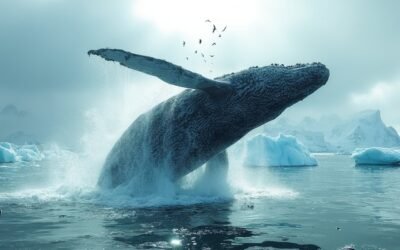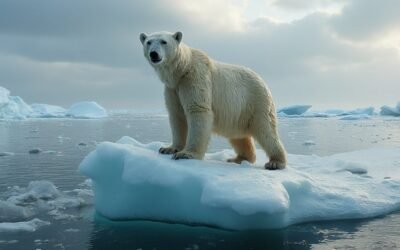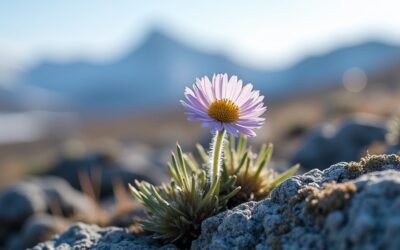Melting ice caps pose a significant threat to polar bears, primarily through the loss of their natural habitat. As the Arctic ice melts rapidly due to climate change, you'll see that polar bears are deprived of vital hunting grounds. They rely on sea ice as a platform to hunt seals, which are their primary food source. With less ice, bears must swim longer distances, increasing their energy expenditure, and often leading to longer fasting periods. This decline in hunting opportunities weakens their overall health and disrupts reproductive patterns. Additionally, young cubs face higher mortality rates under these conditions. Further insights reveal more about these impacts on polar bear populations.
Main Points
- Melting ice caps reduce sea ice, depriving polar bears of essential hunting grounds.
- Loss of ice forces polar bears into longer, energy-draining swims.
- Extended fasting periods due to reduced hunting opportunities weaken polar bears.
- Disrupted mating routines and breeding grounds lower reproductive success.
- Cubs face higher mortality rates due to declining body condition and habitat loss.
Polar Bears' Shrinking Habitat
As the Arctic sea ice continues to melt, polar bears are losing their essential hunting grounds. This stark reality is reshaping the existence of these iconic Arctic inhabitants. With the Arctic warming nearly four times faster than the global average, the rapid loss of sea ice isn't just a pivotal change but a dire shift impacting the entire ecosystem. This loss deprives polar bears of their natural habitat, vital for hunting seals, their primary food source, and for mating and resting.
Polar bear populations across all 19 subpopulations are witnessing this transformation as their ice-covered home diminishes. Climate change, driving these temperature rises, is the main culprit behind the melting ice. This environmental upheaval forces polar bears to adapt to a landscape less suited to their traditional ways of life. As ice platforms disappear, so does the ease with which these bears can reach their prey, leading to longer fasting periods and increased mortality rates.
In regions with only seasonal ice, the situation is even more precarious. Here, polar bears face the greatest threat, as the ice-free periods extend. This forces them into longer swims and sometimes pushes them into human-populated areas in search of food, creating further conflict and stress on their populations.
This habitat reduction not only affects their dietary habits but also alters their reproductive patterns, threatening the survival of future generations. The continuity of the species is at stake, with every patch of melting ice signaling a potential step towards their decline. The interconnectedness of Arctic health and polar bear survival couldn't be clearer, underscoring the urgent need for action against climate change.
Sea Ice Loss Explained
Understanding why Arctic sea ice is disappearing is essential, as it's the primary platform from which polar bears hunt, mate, and rest. The loss of this critical habitat, driven by melting ice caps, poses a severe threat not just to individual bears but to the entire global population of this iconic species. Here are key reasons why sea ice is vanishing:
- Increased Global Temperatures: As global temperatures rise, the Arctic region is affected disproportionately, leading to faster melting of ice.
- Albedo Effect Reduction: Sea ice reflects sunlight, helping to keep the area cool. As ice melts, darker ocean water absorbs more heat, accelerating further ice loss.
- Rising Sea Levels: Warmer temperatures expand ocean water and increase melting from glaciers and ice sheets, contributing to reduced sea ice.
- Atmospheric Patterns: Changes in wind patterns and atmospheric warmth can diminish sea ice extent and thickness, making the ice less stable for polar bear activities.
This sea ice loss forces polar bears to endure longer swims and spend more time on land, where hunting is more challenging and less effective. As a result, polar bears are pushed to adapt to rapidly changing conditions, increasing their risk of extinction if they can't find sufficient food on land.
The melting ice caps, hence, aren't just a symptom of climate change but a dire warning about the sustainability of life in the Arctic, including that of the polar bears. Without significant efforts to mitigate these changes, the future of the Arctic's most iconic inhabitant looks increasingly bleak.
Impacts on Hunting Practices
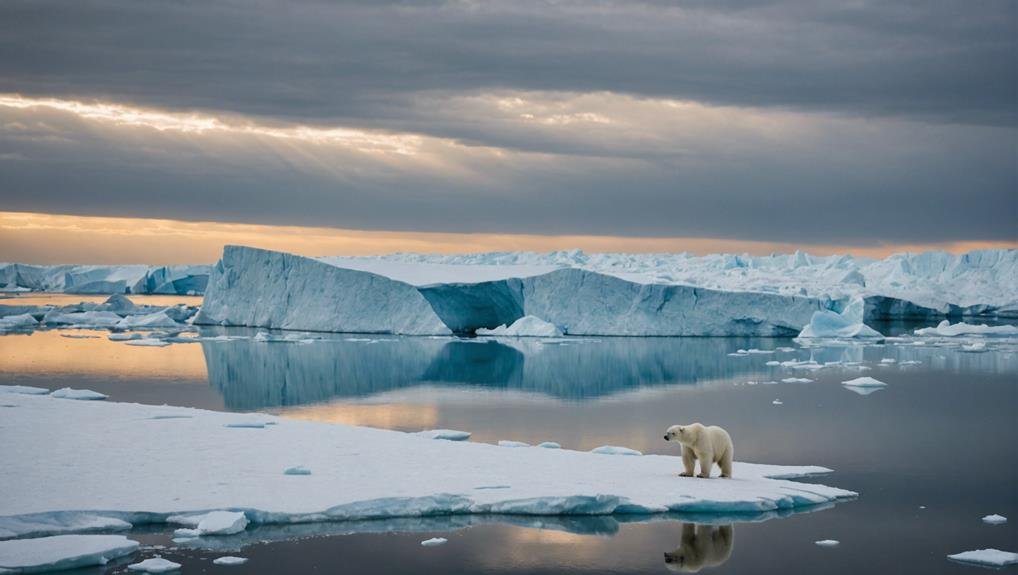
Melting ice caps are dramatically altering polar bears' traditional hunting practices, forcing them to adapt quickly or face severe consequences. As a polar bear expert might tell you, these majestic creatures depend heavily on sea ice habitat to hunt their primary prey, seals. However, with the ice melting sooner and forming later each year, their hunting season is greatly shortened. This reduction not only impacts their ability to find food but also affects their reproductive success.
You'd notice that polar bears are now swimming longer distances to find suitable hunting grounds, which is a direct result of the disappearing sea ice. This extended effort requires more energy, contributing to a declining body condition among the bears. The shorter hunting season and longer fasting periods are particularly harsh on pregnant females, who need substantial reserves to birth and nurse their cubs. Consequently, cub survival rates are dropping, indicating dire survival challenges for future generations.
Moreover, the disruption to their traditional hunting behaviors poses significant adaptation challenges. Polar bears are skilled hunters on ice but finding and capturing prey in open water or on unstable ice is much more difficult. Their entire way of life, evolved over millennia around a stable sea ice environment, is being upended.
As you can see, the survival of polar bears is intricately linked to their sea ice habitat. Without it, their fundamental practices for feeding and breeding are compromised, threatening the overall health and sustainability of their populations. The pressing question now is, how effectively can polar bears adapt to these rapid changes, or what'll be their fate if they can't?
Increased Starvation Risks
With the ice caps dwindling, polar bears are facing increased risks of starvation as their primary hunting grounds disappear. As you explore the plight of these majestic creatures, you'll find that their survival is becoming increasingly precarious. The melting ice caps aren't just a visual spectacle of climate change; they spell dire consequences for the polar bear populations relying on sea ice to hunt and feed.
Here's what you need to know about the impact of melting ice on polar bears:
- Essential: As sea ice melts, the platforms from which polar bears hunt seals are vanishing. This loss drastically reduces their ability to find and catch their primary food source, leading to heightened starvation risks.
- Investigate: With less sea ice, polar bears are forced to endure longer periods without food. These extended fasting times negatively affect their body condition, weakening their health and reducing their chances of survival.
- Energy Expenditure: The need to travel further to find stable ice or prey means polar bears use more energy. This increased expenditure, without a corresponding increase in food intake, contributes to their declining body condition.
- Disrupted Feeding Patterns: The traditional hunting and feeding rhythms are out of sync as the ice retreats earlier and forms later each year. This disruption makes it challenging for polar bears to maintain a regular feeding schedule, important for their survival during harsh conditions.
Forced Longer Migrations
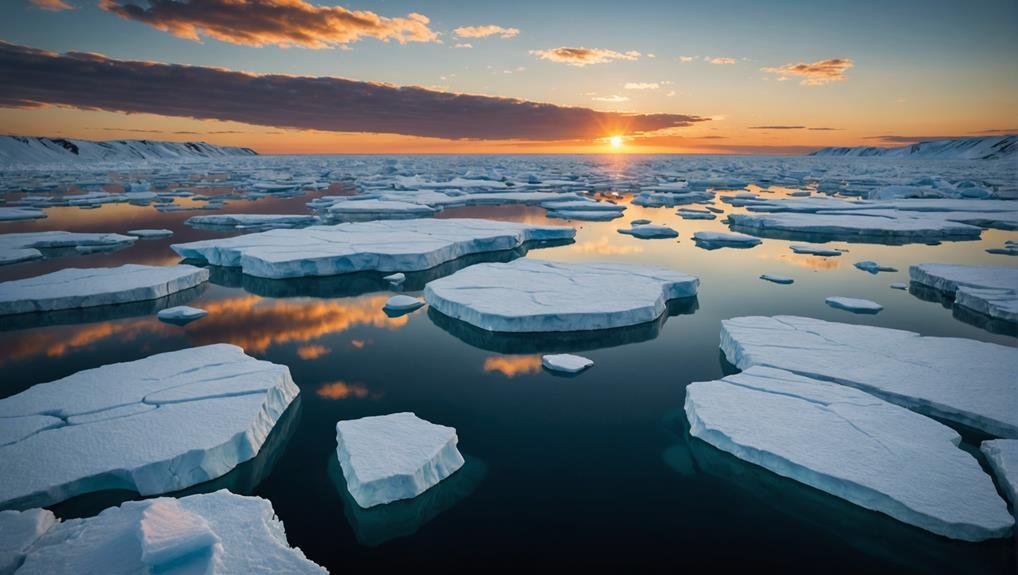
Polar bears now face grueling, longer migrations to find dwindling hunting grounds as ice caps continue to melt. As you imagine these majestic creatures traversing vast, icy landscapes, it's important to understand that their journey isn't just physically demanding but a desperate quest for survival. With sea ice melting at alarming rates, the once abundant hunting areas rich in seals are vanishing, forcing polar bears to travel greater distances.
These longer migrations aren't just a matter of extra miles. They translate into notably increased energy expenditure. Every additional mile swum or trekked in the arctic chill drains essential energy reserves of polar bears—energy that's critical for hunting and breeding. This heightened energy demand can lead to exhaustion, reducing their effectiveness as hunters and impacting their health.
Moreover, the reduced sea ice extent means that the time windows for hunting are shrinking. Polar bears rely heavily on sea ice as platforms from which to hunt seals. Without these platforms, not only is hunting success diminished but the opportunity to eat and regain energy before the next journey is also lessened.
This ongoing strain isn't just a physical toll. It elevates stress levels among polar bears, contributing to broader implications for their well-being and reproductive success. High stress can affect immune response and overall health, making polar bears even more vulnerable.
The culmination of these challenges is a grim outlook for population stability. As their habitat continues to degrade, polar bears face potential population declines, with fewer cubs surviving to adulthood and fewer adults living healthy lives. Each step they take on ice is a step towards an uncertain future, battling against a changing world.
Effects on Cub Survival
One can't overlook the profound effects that longer fasting periods have on the survival rates of polar bear cubs. As the ice caps continue to melt, largely due to climate change, the natural habitat and hunting grounds of polar bears shrink, leading to extended fasting periods. These periods are particularly detrimental to the health and survival of vulnerable cubs, who are less equipped to handle prolonged periods without food.
Here are key impacts on cub survival caused by melting ice caps:
- Increased Mortality Rates: Extended fasting periods reduce the cubs' chances of reaching adulthood. With less time for mothers to hunt, cubs often don't receive the necessary nutrition to develop properly, leading to higher mortality rates.
- Declining Body Condition: The declining body condition of mother bears during longer fasting directly impacts their ability to nurse and care for their cubs. Weaker mothers may lead to weaker cubs, who are less likely to survive in the harsh Arctic environment.
- Lower Reproduction Rates: As female polar bears experience stress and reduced body condition from lack of food, their reproductive rates decline. This means fewer cubs are born each season, exacerbating the decline of the species.
- Cub Recruitment Challenges: With fewer resources and reduced hunting time, fewer cubs are recruited into the population each year. This recruitment difficulty further threatens the long-term viability of polar bears as a species.
In essence, the melting ice caps are creating a dire situation for polar bear cubs, making their survival increasingly precarious in a rapidly changing Arctic ecosystem.
Disruption of Mating Routines
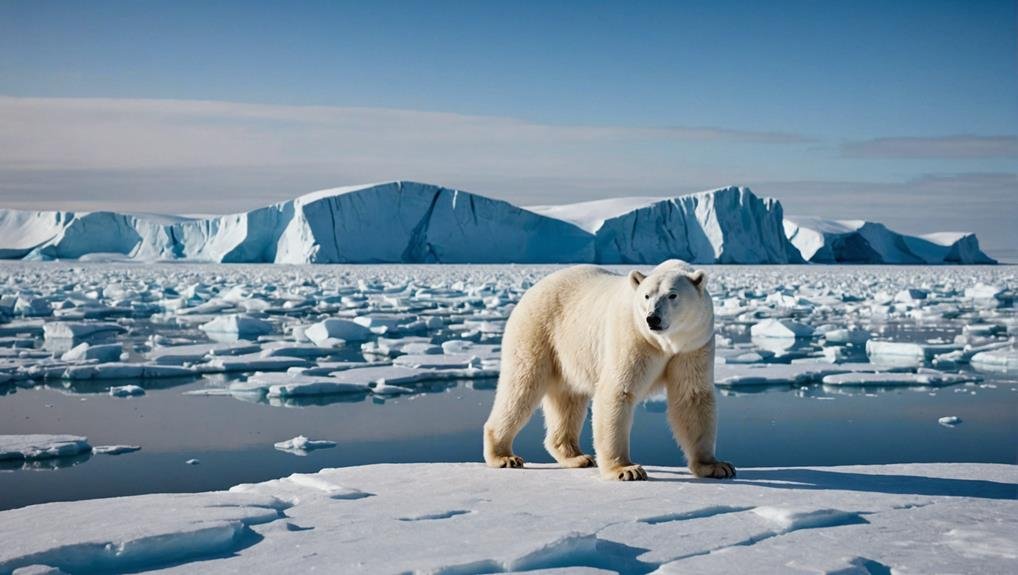
Melting ice caps frequently disrupt the mating routines of polar bears, altering their traditional breeding grounds and impacting reproductive success. As you explore further into this reality, you'll find that the decline in sea ice extent critically limits access to the preferred mating areas for these majestic creatures. This isn't just about less ice; it's about the very arenas where polar bears have historically sought out partners, now disappearing or becoming inaccessible at times essential for mating.
This disruption isn't merely a matter of inconvenience. The changes in ice conditions directly affect the timing and success of polar bear mating behaviors. Imagine you're a polar bear, adapted to a specific rhythm of life, only to find that the environmental cues that dictate your reproductive cycle are increasingly out of sync. The sea ice, once dependable, now forms later and melts sooner, compressing or shifting the timeframe in which you can find a mate and successfully reproduce.
Moreover, the reduction in suitable ice habitats impacts your ability to find mates and reproduce effectively. Suitable habitats aren't just places to live; they're integral to the complex process of mate selection and breeding. With fewer and less reliable breeding grounds, the chances of encountering a mate dwindle, reducing genetic diversity and weakening the overall health of future generations.
As polar bears face these challenges, it's clear that melting ice caps aren't just transforming their physical landscape but are also reshaping their most fundamental life processes. The disruption of mating routines is a poignant example of how environmental changes exert profound effects on species survival.
Threats to Arctic Biodiversity
Amid the broader crisis of global warming, the rapid loss of sea ice poses severe threats to Arctic biodiversity, including important species such as polar bears. As you explore further into the subject, you'll uncover the profound impacts this environmental change has on these majestic creatures and their ecosystem.
- Loss of Hunting Grounds: Polar bears primarily rely on sea ice as a platform from which to hunt seals, their main food source. Melting ice caps dramatically shrink their hunting territory, forcing polar bears to travel greater distances and expend more energy to find food, which can lead to starvation and reduced reproductive success.
- Habitat Disruption: The Arctic habitat is intricately tied to the presence of sea ice. As it diminishes, the entire ecosystem's balance is disrupted. This not only affects polar bears but also other species that are part of the Arctic food web, leading to a cascade of biodiversity loss.
- Longer Fasting Periods: With less ice, polar bears face longer periods of fasting. During the ice-free seasons, bears have limited access to their primary prey, which significantly impacts their body condition, reproductive rates, and cub survival.
- Urgency for Conservation: The ongoing loss of sea ice highlights the essential need for immediate and effective conservation efforts. Protecting the Arctic environment and addressing the root causes of global warming are crucial to preserve the polar bears and the unique biodiversity of the region.
Understanding these challenges is important for supporting conservation strategies that can mitigate the adverse effects of global warming on the Arctic and its inhabitants.
Frequently Asked Questions
Why Are Ice Caps Important to Polar Bears?
Ice caps are vital for polar bears as they provide essential seal hunting grounds and cubs' birthing areas. These ice platforms facilitate polar navigation skills and help maintain traditional migratory paths.
The melting of ice caps impacts genetic diversity and the ice albedo effect, altering climate adaptation strategies for polar bears. Ultimately, the reduction of these ice cap ecosystems threatens the survival and health of polar bear populations.
How Does Melting Polar Ice Caps Affect Animals?
As the ice caps melt, you're witnessing a domino effect across Arctic ecosystems. Arctic fox survival is jeopardized due to disrupted prey availability. Seal hunting becomes strenuous for predators, exacerbating walrus habitat loss.
Migratory birds face altered habitats, while krill populations decline, affecting whale migration patterns. Changes in fish distribution disrupt local fishing industries, and reindeer struggle with feeding disruptions.
Each species feels the ripple effects, highlighting the interconnectedness of this fragile ecosystem.
What Are 5 Reasons Why Polar Bears Are Endangered?
You're asking about the key reasons polar bears are endangered. Apart from climate change impacts, hunting restrictions, loss of genetic diversity, increased disease spread, human encroachment, and pollution greatly affect them. These factors lead to higher starvation rates as bears can't accumulate necessary fat reserves.
Additionally, behavioral changes due to stress from environmental pressures further threaten their survival. Each of these reasons contributes to the critical status of polar bear populations worldwide.
What Are the Negative Effects of Melting Polar Ice Caps?
Imagine Earth wearing its ice caps like a hat that's now too small—truly, the planet is heating up!
The melting ice caps trigger sea level rise, coastal erosion, and increased flooding, disrupting habitats globally.
Ocean circulation changes, coupled with released greenhouse gases and thawing permafrost, exacerbate climate feedback loops.
These shifts aren't just statistics; they signify real threats to ecosystems and human communities, demanding urgent attention and action.
How Does Understanding Polar Bears Help Us Address the Dangers of Melting Ice Caps?
Understanding polar bears and ice is crucial to addressing climate change. Polar bears rely on sea ice for hunting and living. As ice caps melt due to global warming, their survival is at risk. Studying how they adapt offers key insights into the broader impacts of ice loss on the environment.
Conclusion
Ironically, as you enjoy a colder drink on a warmer day, polar bears are losing their icy homes. The melting ice caps aren't just a distant concern; they're reshaping the Arctic ecosystem.
With less sea ice, polar bears find hunting seals tougher, migrations longer, and survival rates of cubs lower. Disrupted mating routines and increased starvation underscore the cascading effects on Arctic biodiversity.
So, while we adapt our room temperatures, polar bears are running out of room to roam.
